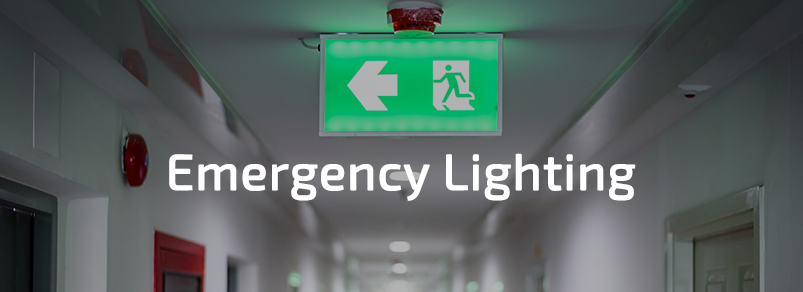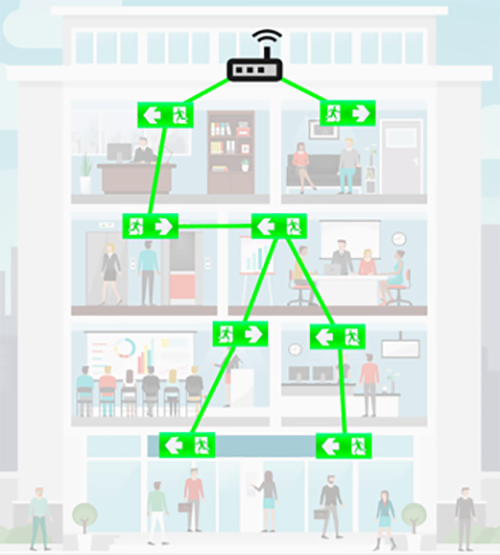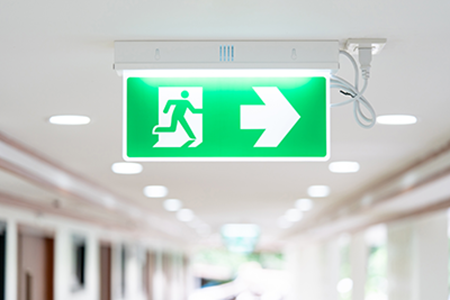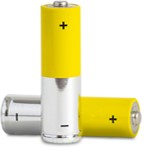Schedule a Teams Meeting with Radiocrafts or leave a message on our contact form to learn more about our long range mesh communication solution, RIIM, optimized for an efficient wireless emergency lighting network!

Do you need an ultra-low power, long range, highly reliable wireless communication mesh solution for your emergency lighting network? A network capable of covering an entire building complex on a single gateway with up to 1000 emergency lights? Then Radiocrafts’ Industrial IP Mesh (RIIM) is the solution for you!

Cover an entire building with up to 1000 emergency lights per gateway

Superior range and penetration in concrete buildings

No license/subscription fees, everything included in the module

Unmatched reliability in data transmission success rates

15+ years of battery operation

Quick and easy to integrate, vast flexibility in gateway placement
Radiocrafts’ Solution For Wireless Emergency Lighting Networks – RIIM

RIIM by Radiocrafts is an easy-to-use, Sub-GHz, wireless communication network completely embedded in an RF module. It includes all the critical components for a complete wireless network and has no license fee or subscription costs. It is ready to go when you buy the module. Additionally, since RIIM is a mesh network, it is self-forming, self-healing and self-optimizing. As a result, the emergency lighting networks’ installation, integration, and implementation process is great simplified.
RIIM provides your Wireless Emergency Lighting Network with:
Exceptional Long Range and Scalability
A RIIM network supports several features allowing you to easily cover building complexes as large as 5.6 square kilometres long (3.5 miles). For example, RIIM supports a range of up to 150 meters between each emergency light, including inside a building with reinforced concrete. Furthermore, a RIIM data packet can spread across the network by hopping from device to device up to 28 times (28 mesh hops maximum).
Your emergency lighting network can also have up to 1000 emergency lights for a single border router (gateway). This creates gateway placement flexibility and reduces the cost of installation significantly. A massive building complex only requires one gateway to support a large scale deployment.
Read more about RIIM range test results, including inside our building complex in the application notes below.
In addition, a RIIM Mesh Router can handle down to 35uA @ 3.3v average power consumption enabling all battery devices in the network to further extend the network coverage. 20 uA in 150 kbps mode.
RIIM operates on the 868/915 MHz frequency bands which offer much better range than the 2.4 GHz frequency band solutions.

Unmatched Robustness and Reliability
RIIM provides unmatched reliability in data transmission success rates for wireless Emergency Lighting networks thanks to the supported Time-Synchronized Channel Hopping and Adaptive Frequency Agility features.
Time Synchronized Channel Hopping (TSCH) works by transmitting data packets at several frequencies and at different time slots in a synchronized schedule. If a data packet is lost, it will be re-sent on a different channel in the next available time slot. It is a channel hopping mode designed to make a mesh with less packet collisions and higher reliability. A TSCH network has proven to have a reliability of up to 99.99%.
Adaptive Frequency Agility (AFA) provides industry-leading low latency data throughput with minimal packet loss by taking the allowed duty cycle in Europe from 1% to around 40%! AFA works by scanning all channels and marking the ones which are often found to be noisy. Those channels are then dropped ensuring that the radio only uses the best channels with the least noise.
Emergency Lighting networks benefit greatly from the unmatched reliability this combination of features provides, especially in networks located in building complexes where the floors and walls are made of reinforced concrete and high levels of interference from other radio solutions are present. Radio coverage planning is simplified significantly by good penetration in building material. Emergency lights mounted in hard-to-reach places like the corner of a building parking lot can also be reached. In addition, localised sensors can identify a hazardous location and use emergency lights to reliably show the path to safety.
Learn more about TSCH and Adaptive Frequency Agility in the application notes and demos below.

Efficient Local Control and Maintenance of Devices
RIIM provides efficient local control and maintenance of nodes through mist computing and two-way symmetrical communication. This combination enables Over-The-Air updates as well.
RIIM includes the ICI framework. An ICI application is always running on the module to tailor the modules’ behavior to the customers’ unique requirements. The ICI application, in its simplest form, is just configuring the modules’ hardware interfaces, the radio network, and defines when to read and write to those interfaces. ICI also supports mist computing which allows you to control each emergency light and sensor locally, significantly reducing bandwidth requirements. Mist computing also provides fast responses to local events such as, performing real-time monitoring of room status and hazards, alerts for end-of-life products, lamp/LED/battery failures, generating analytics to determine building occupancy rates and traffic patterns, testing of luminaires, integrating with building and access systems, and more.
A RIIM network supports 2-way symmetrical communication which is essential for Over-The-Air updates. This means that you can update your user-defined ICI firmware when the network is deployed and in full operation. You can add new sensors/controllers when the need arises and broadcast messages of new schedules efficiently. With emergency lighting networks, often times, many sensors and emergency lights are located in hard-to-reach places and will be in operation for a long time, so touch less updates of firmware is important.
Explore an example code in ICI in the application note below.

Market-Leading Low Power For Battery Operated Devices
RIIM is very low power for battery operation supporting long lasting projects.
RIIM has a number of features that reduce power consumption enabling 15 years battery lifetime on 2 AA batteries. These include:
- The chosen electronic components inside are low power to start with.
- The network end nodes can be put in “Sleepy” mode, reducing the current consumption to 4.7 uA. In deep sleep mode, the power is reduced even further to 2.8 uA.
- The output power of the module is configurable, not to consume more power than needed during transmit.
- RIIM nodes can sleep when there is no time slot for incoming or outgoing RF data packages.
- The RIIM nodes can handle down to 35uA @ 3.3v average power consumption enabling all battery devices in the network to further extend the network coverage. 20uA in 150 kbps mode
- The customer can save substantial power with data processing. RIIM supports cloud computing which means that instead of sending all raw sensor reading data to the Cloud, the user can just send the interesting data, such as an alarm when a threshold is met.

Read more about RIIM’s low power capabilities in the application notes below.
Quick and Easy Cloud Connectivity
RIIM is also designed to have direct cloud connection using protocols such as IPv6, UDP, CoAP and DTLS. This eliminates the need for a dedicated gateway and offers direct end-to-end IP packet communication with end-to-end security. Furthermore, RIIM can operate in a local mode where no internet connection is used.
You can also extend RIIM with an edge gateway which serves as a network entry point for devices talking to cloud services. You can then have an external cloud connection from the gateway device. This is useful when the user intends to implement some edge-computational functions, thus decreasing latency. It can also be useful in case connection to the cloud is lost. In addition, the gateway does not need to be a specific IoT gateway, it can actually be a PLC (Programmable Logic Controller), a Raspberry Pi (or any Linux host), or a computer.
Read more about connecting RIIM with an edge gateway in our application note below.
Also visit Radiocrafts’ GitHub page for a sample code on how to connect a RIIM network to an edge computer.
RIIM Support Tools
We recommend you buy a RIIM Development Kit in your early stage product evaluation. The development kits are designed to be easy to use and to very quickly support a wireless link or network, where you can make a good analysis of the network performance.
RIIM is supported in most countries in the world. Explore the possibilities of using RIIM in your country in the application note below!
Buy the RIIM Development kit from:
- Digi-Key
- Or from a distribution partner in your country.
Read more about the RIIM Network here.
Learn about the different RIIM Parts and Tools here.
Read our extensive documentation on RIIM, including datasheets, User Manuals, Development Kit documentation, Application Notes and more, here.
Download Software Tools for RIIM here.
Watch tutorial videos on how to use the RIIM Development Kit here.
Schedule a Teams Meeting with Radiocrafts or leave a message on our contact form to learn more about our long range mesh communication solution, RIIM, optimized for an efficient wireless emergency lighting network!
